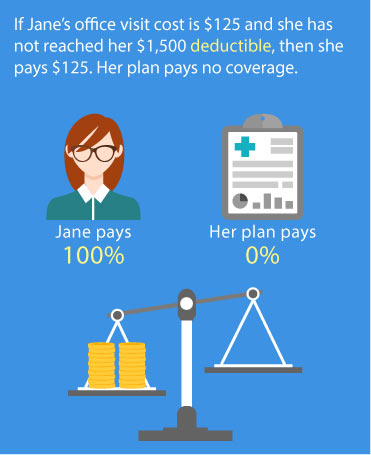Insurance Terms
Knowing just a few key terms can help you ask good questions, lead to more productive conversations with your healthcare providers and lower your out of pocket costs. This guide is intended to be helpful but it is always best to be familiar with the details of your own plan.
Deductible
The amount of money you pay out of pocket each year before your insurance will begin covering expenses. Deductibles usually start over at the beginning of each calendar year. The deductible may not apply to all services
Example: If you have a $2,000 deductible, you pay the first $2,000 of your own medical expenses. This is called meeting your deductible. After that, your insurance will pay some of your medical expenses. You may still have to pay a portion of your expenses through copays and coinsurance.

Co-pay
A fixed amount you need to pay for certain medical services, usually at the time of service. Office visits and prescription medicines often require copays.
Example: A visit to the family doctor may require a $25 copay, while an emergency room visit may involve a larger copay. Some services require both a copay and coinsurance.

co-insurance
Co-insurance begins after you've met your deductible and your plan starts paying some of the cost, it is the amount you pay after your insurance has paid its portion of the bill. Co-insurance is calculated as a percentage of total cost rather than a fixed dollar amount.
Example: You've reached your deductible for the year and the cost of your next doctor's visit is $100. If your co-insurance is 20%, that means you will be responsible for $20 and your insurance plan will pay the remaining $80.

out-of-pocket maximum
The maximum amount of money you can pay for medical services over a certain period of time, usually per year. Once you meet your out-of-pocket maximum, your insurance plan will pay 100% of all allowed charges.
Example: Your insurance plan includes an out-of-pocket maximum of $4,000. You have met your $2,000 deductible and paid an additional $2,000 in copays and coinsurance. Your insurance will now pay 100% of any future necessary and allowed medical charges until your policy renews the following year.

allowable vs. billed charges
The allowable charge is the price that your insurance company will pay for a particular medical service. The allowable amount then also determines how much you pay in coinsurance. You pay a portion of the total allowed amount in the form of a copayment, coinsurance, or deductible. Your health insurer pays what's left. The billed charge is usually higher than the allowable charge. Whether the provider is in-network or out-of-network with the insurance company determines who is responsible for the difference between the allowable and the billed amounts. An out-of-network provider can charge you that balance and it can be a significant amount.

in-network vs. out-of-network providers
In-network providers are clinics and physicians that have agreed to charge your insurance company discounted rates for medical services. They are also called "preferred providers". Because of these negotiated rates typically you will pay less by going to an in-network provider plus, unlike out-of-network, you cannot be asked to make up the difference between the allowed amount and the amount the provider chooses to bill.

preauthorization (prior approval or precertification)
Some medical procedures and medications require your insurance company's approval beforehand, called preauthorization. If preauthorization is required, but not obtained, your insurance plan may determine it will not cover the cost. Even receiving pre-authorization is not always a guarantee that the cost will be covered and to be sure you're covered always contact your insurance before moving forward with a treatment or procedure.

You are having surgery
What are the potential charges that may occur?

Surgeon's fee
The surgeon's office will be able to provide you with an estimate of the fees. These fees are based upon charges; however, VENT has special contracted rates with most insurance carriers which allows the charges to be adjusted down to "allowable rates" (see more about allowables in the definitions of insurance terms).

Surgery center:
The surgery center will have separate fees and your surgery scheduler will provide you with the name and phone number of the surgery center to be used so you may call them and review estimated charges directly with them. In most cases VENT uses in-network surgery centers (see definitions). When calling, be sure to verify that the surgery center is in-network by providing your insurance information.

Hospitals:
Your surgery may be scheduled at a hospital rather than a surgery center. Your surgery scheduler will provide you with the name and phone number of the hospital where the surgeon will perform your surgery. We recommend you call the hospital in advance of your surgery to discuss insurance coverage.

Radiologist:
In some cases a radiologist may be required for performance and/or interpretation of tests. There may be charges for radiology.

Anesthesia:
Your surgery will require anesthesia. The surgery scheduler will provide you the name and number of the anesthesia service so that you may call them to review your insurance coverage and their charges.

Other services:
Other services may be required.
Each VENT office has an individual surgery contact person to help you with what to expect. However please understand that surgical procedures and individual insurance plans do vary and while your surgery scheduler can be an excellent resource for your questions about the services needed and their estimated costs, they will not be able to give you the absolutely exact and final amounts ahead of time.
How you and your insurer share costs
Example
Jane's insurance plan has a $1,500 deductible. The Co-insurance is 20% with an Out-of-Pocket Limit of $5,000.


